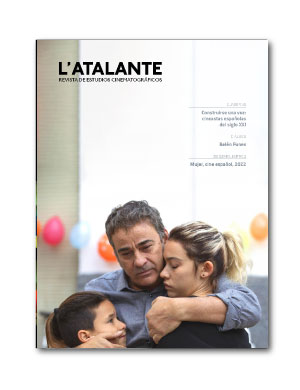Published 2022-01-30
Keywords
- Icíar Bollaín,
- Discurso,
- Estilo,
- Análisis cinematográfico,
- También la lluvia
- Mirada narrativa ...More
How to Cite
Copyright (c) 2022 L'Atalante. Journal of film studies

This work is licensed under a Creative Commons Attribution-NonCommercial-NoDerivatives 4.0 International License.
Abstract
Icíar Bollaín's filmography has come to constitute a necessary and profound oeuvre in Spanish cinema. Her films fit in various movements: social cinema, feminist cinema, and filmmaking with a personal style. In her directorial discourse, her distinct style and her particular view of the world converge in the filmmaking act. An analysis of Even the Rain (2010) reveals elements present in the discourse in the form of expressive devices that are common in filmmaking, but which are reworked and reconfigured to become features of her own style. The approach taken in this film represents a leap in her filmography. However, an in-depth analysis shows that the artist’s gaze, far from being altered or blurred, is transformed and consolidated into a clear style and a discourse that transcends genres and labels.
Downloads
References
<p>Aumont, J., Marie, M. (1990). <em>Análisis del film</em>. Barcelona: Paidós.<br>
Barrenetxea Marañón, I. (2014). <em>También la lluvia</em> (2010), de Icíar Bollaín: El Redescubrimiento (Amargo) de América. En T. Fernández Ulloa (ed.), <em>Changes, Conflicts and Ideologies in Contemporary Hispanic Culture</em> (pp. 453-475). Newcastle: Cambridge Scholars Publishing. <br>
Bollaín, I. (2003a). El cine no es inocente. <em>DUODA. Revista d’estudis feministes</em>, <em>24</em>, 83-88. Recuperado de https://raco.cat/index.php/DUODA/article/view/62924 <br>
Bollaín, I. (2003b). Cine con tetas. <em>DUODA. Revista d’estudis feministes</em>, <em>24</em>, 89-93. Recuperado de https://raco.cat/index.php/DUODA/article/view/62926 <br>
Caballero Wangüemert, M. (ed.) (2011). <em>Mujeres de cine: 360° alrededor de la cámara</em>. Madrid: Biblioteca Nueva. <br>
Castellani, J.-P. (1996). Icíar Bollaín, la crisálida del cine español. <em>Hispanística XX</em>, <em>14</em>, 163-182. Recuperado de https://dialnet.unirioja.es/servlet/articulo?codigo=3609087 <br>
Castells Molina, I. (2017). Visiones y revisiones de la conquista en el cine, desde Werner Herzog hasta Icíar Bollaín. En A. Cano Ginés y C. Brito Díaz (eds.), <em>Oro y plomo en las Indias. Los tornaviajes de la escritura virreinal</em> (pp. 239-258). Madrid: Iberoamericana.<br>
Chatman, S. (2021). <em>Story and Discourse. Narrative Structure in Fiction and Film</em>. Ithaca: Cornell University Press. https://doi.org/10.1515/9781501741616<br>
Cibreiro, E. (2015). El cine social y comprometido de Icíar Bollaín: hacia una perspectiva global, transcultural y ecologista. <em>España contemporánea. Revista de literatura y cultura</em>, <em>24-25</em>(2-1), 161-173. Recuperado de https://dialnet.unirioja.es/servlet/articulo?codigo=5970228 <br>
Díaz, L. T. (2016). La ‘mirada femenina’: estereotipos y roles de género en el cine español (1918-2015). <em>Ámbitos. Revista Internacional de Comunicación</em>, (34). Recuperado a partir de https://revistascientificas.us.es/index.php/Ambitos/article/view/930<br>
Hernández Miñano, P., Castellote Herranz, N., Martín Núñez, V. (2015). Filmar / ser filmada. El trabajo actoral según Icíar Bollaín, cineasta y actriz. «Los actores son grandes guionistas porque se inventan cosas que el guionista tendría que haber escrito». <em>L’Atalante. Revista de Estudios Cinematográficos, 19</em>, 68-80. Recuperado de http://www.revistaatalante.com/index.php?journal=atalante&page=article&op=view&path%5B%5D=266 <br>
Leoni-Hughes, H. (2021).La reproducción de narrativas coloniales en <em>También la lluvia</em> y su relación a la política boliviana. <em>PORTALES: The LAIC Undergraduate Journal of the Department of Latin American and Iberian Cultures</em>, <em>5</em>(1), 1-8. Recuperado de https://journals.library.columbia.edu/index.php/portales/article/view/7660/4070<br>
Llorente, N. (2019).Retóricas y estéticas del Descubrimiento de América en <em>También la lluvia</em> (2010), de Icíar Bollaín. <em>Quaderns de Cine</em>, <em>14</em>, 21-31. https://doi.org/10.14198/QdCINE.2019.14.03<br>
McKee, R. (2011). <em>El Guion Story. Sustancia, estructura, estilo y principios de la escritura de guiones</em>. Barcelona: Alba Minus.<br>
Osorio, M. (2015). Discursos en contienda: <em>También la lluvia</em> de Icíar Bollaín. <em>Revista Iberoamericana</em>, <em>81</em>(251), 523-537. https://doi.org/10.5195/reviberoamer.2015.7278<br>
Paszkiewicz, K. (2012). Del cine épico al cine social: el universo metafilmico en <em>También la lluvia</em> (2010) de Icíar Bollaín. <em>Lectora: revista de dones i textualitat,</em> <em>18</em>, 227-240. https://doi.org/10.2436/20.8020.01.47 <br>
Sánchez-Escalonilla, A. (2008). <em>Estrategias de guion cinematográfico</em>. Barcelona: Ariel.<br>
Sánchez Noriega, José Luis. Icíar Bollaín (2021). Ediciones Cátedra. 448 pp <br>
Vargas-Machuca, M. D. (2017). Cine dentro del cine, Historia dentro de la historia: También la lluvia (Icíar Bollaín, 2010). <em>Procesos históricos: revista de historia, arte y ciencias sociales</em>, <em>31</em>, 168-184. Recuperado de https://www.redalyc.org/journal/200/20049680015/html/</p>
</body>

